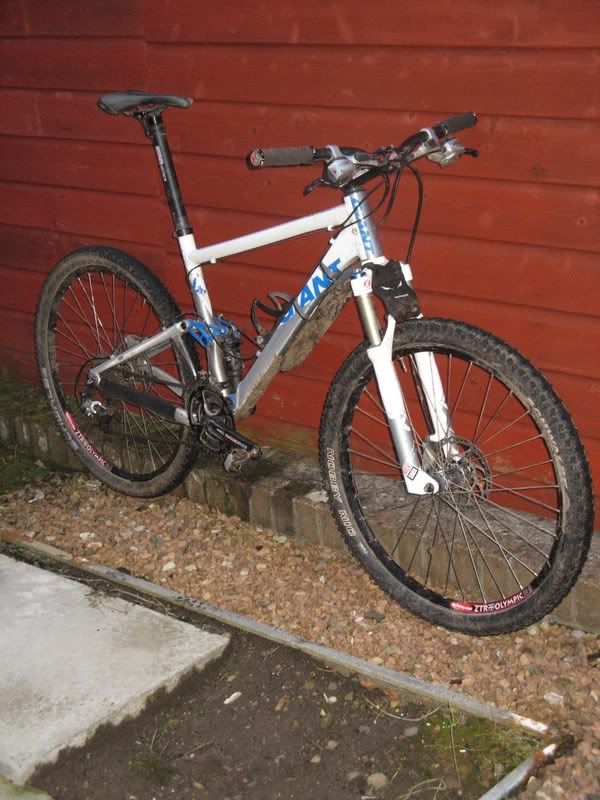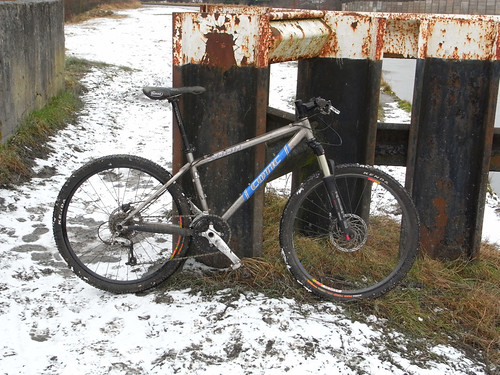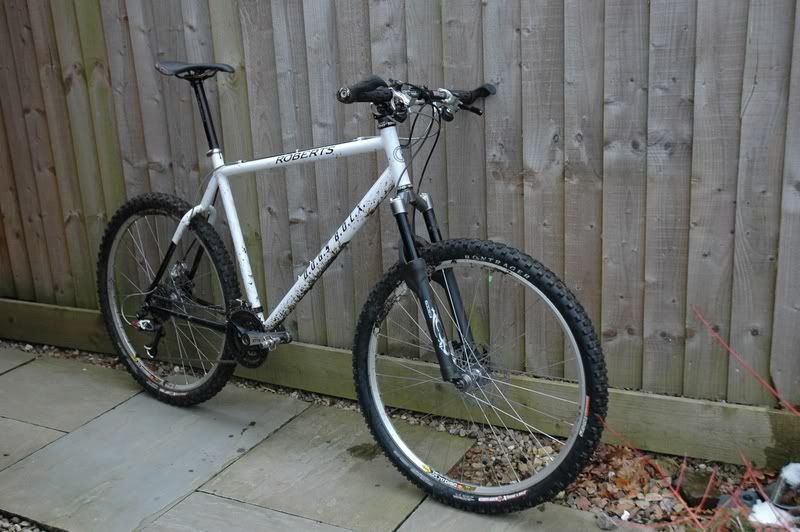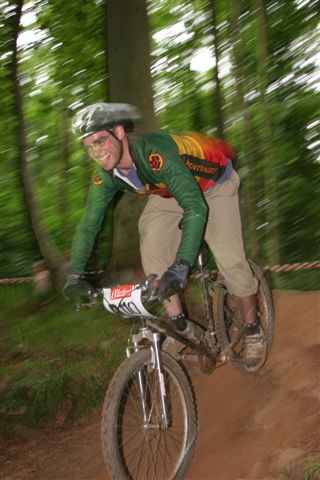- This topic has 36 replies, 25 voices, and was last updated 15 years ago by MrAgreeable.
-
Flat bars on XC race bikes….Why?
-
pinchesFree MemberPosted 15 years ago
After having a conversation with someone about racing XC next year, i saw a thread about “sahweeetest hardtails” on here, to which some people posted their XC race bikes, a comment was made along the lines of “some people have funny ideas about race bikes, riser bars, flat pedals and no bar ends”
i’m just wondering really why flat bars are so good for racing XC? i mean surely it comes down to: the geometry of the frame, rider size and comfort.
i personally could never get on with using flat bars on my scandal, the front end would just be too low for me to be comfortable and i think it would make the bike more nose heavy? in a similar way when i used to use 80mm forks and went up to 100mm ones
just wondering really, i would agree with the SPD comment but at the end of the day surely its rider preference and the geometry of what you ride that dictates?
clubberFree MemberPosted 15 years agoIt is rider preference but there’s a certain amount of ‘what tends to work’ in there too – eg road bikes tend to have a lower front end than mtbs because that works best (for most people) as a balance between comfort, power and aero drag.
XC race bikes are somewhere between trail bikes and road bikes in their requirements to it’s not really suprising that (again, for most people) the position is between the two and that means that flat bars are generally about right – why use risers if you don’t need them.
Also, don’t forget that if you’re not used to a relatively low front end, you’re probably not flexible enough (hamstrings) to feel comfortable in that position.
HTTP404Free MemberPosted 15 years agomost people opt for risers for added height and width. you can get wide flat bars as well.
btw bar ends are great and work really well in practice. unfortunately they don’t look so good on risers – which is not to say they wouldn’t work.
PeterPoddyFree MemberPosted 15 years agoI’ve tried bar ends on risers (Sorry…!) and found they don’t work too well with the extra width and sweep. For me, anyway…
I put some wider flat bars (640mm-ish) on my SS Inbred with bar ends and it climbs like a demon, especially with 115mm Rebas locked out. And I love my risers, I was using them very early on when they came out and thought I’d never go back to flats. But hey-ho, they DO work, it just has to be for the right reasons, IMO
😀
coatesyFree MemberPosted 15 years agoAs clubber says, rider preference. I guess a lot of xc racers have been doing it since before riser bars were available an have stuck with it, I wouldn’t trade mine for risers if you paid me, but (unusually, it seems, in mountain biker world)i’m also not worried what you run on your’s or what others think of mine. If you want to try it, give it a go, once you get used to it you may like it.
pinchesFree MemberPosted 15 years agothe question has come about really because i want to replace my carbon bars and i don’t know weather to try some flat ones or get another set of risers.
having read some of the responses i don’t think i’d get on with the flat bars particularly well, the way i see it is i’d be losing 40mm off the height of the front of the bike and i find the scandal to have quite a low front anyway.
thanks for the replys!!
mudsharkFree MemberPosted 15 years agoI built up a bike for racing and put EA70 flat bars on after only using risers on other bikes. Feels different but fine – flat bars are a bit lighter than risers if that matters. BTW, some people think using risers is foolish as should just get the height needed by using an appropriate stem without the extra weight of risers; though obviously risers have different sweeps so comfort may not be right without them for some.
KINGTUTFree MemberPosted 15 years agoI’m toying with the idea of putting a flat bar and bar ends on my Rush for the solo events I’m doing this year, I like the idea of the extra hand positions the set up offers.
I currently use low risers on both my bikes, so the low front end shouldn’t be a problem.
juanFree MemberPosted 15 years agoI don’t get the bar ends even on flats… But that is probably because I have very small hands and holding the side of the bar is plenty enough for me.
gecko76Full MemberPosted 15 years agoFlat bars = head down, arse up.
More power and less control.
What’s not to like?
BigDummyFree MemberPosted 15 years agoThe thing is, if you really watch decent XC racers riding rough or steep sections on their ickle carbon bikes with their roadie set-ups and wimpy slick tyres and their weedy ickle forks and their roadie lycra and their shiney silver shoes they are so ridiculously fast and ballsy that it completely puts me to shame.
🙂
theotherjonvFull MemberPosted 15 years agoflat bars are generally lighter, lower front ended. That would make them more aerodynamic for what that’s worth at MTB speeds, although having said that since most XC races are not contested by bunches swapping out the front like road bunches, what aero benefit there is is likely to be desirable. Also lower front ends are better for climbing, (but potentially worse for descending) and since climbing’s where most XC races are really sorted out, the trade off is probably worth it.
Bar ends are even better for climbing, supposedly allowing you to use your bigger biceps to assist in the pedalling stroke as opposed to triceps when you are on the bars – similar position to hauling on the hoods on a road bike.
I ran bar ends on risers once when recovering from a scaphoid fracture and found the hand position more comfortable. They’d still be on there if it wasn’t a crime against my eyes. I might put them back on for the SDW in the summer, purely for comfort but debating if I’ll need to also get a flat bar in case anyone sees me.
[edit] just read Bigdummy’s post and echo that. As I said ‘potentially worse for descending’ – but since default descending style for most XC riders of a standard sufficiently high that they’re likely to benefit from flats and bars ends is “as fast as you can without a hint of concern for personal safety and pray you don’t crash really badly” – I suspect if someone told them that just holding the stem in an aero tuck was 3 nanoseconds faster per lap they’d be doing that too.
BigDummyFree MemberPosted 15 years agoI think I’d consider a clip-on tri-bar rather than bar-ends for some jobs. 😯
thefettlerFree MemberPosted 15 years agoi have to use barends on my bikes(yes low risers)but with a badly broken elbow some years ago it’s the only way to get a good climbing possy
thisisnotaspoonFree MemberPosted 15 years agoi found bar ends and raisers didnt work as the positions too wide to get any stability, whereas a flat bar is about shoulder width, so felt easier to manage.
my XC bikes going to have raisers, but theres a flat and bar ends waiting to swap to see if it makes a difference.
molgripsFree MemberPosted 15 years agoI’ve used both on my race bikes. I find that flats do indeed make for a good climbing position – the front is lower and I’m quite flexible enough to find it comfortable BUT when descending or winding through Gorrick style twisty singletrack I find there’s far too much weight over the front to do it well. In one Gorrick I found myself almost the entire race winding in and out of trees and it was a massive handful with flats on. With risers, I was able to really hammer the bike and it must’ve saved me a good few minutes per lap.
I have risers on my Kona Heihei which gives me a brilliant riding position. At Bristol Bikefest for example the bike was thrashed absolutely flat out on the technical stuff and it was brilliant. I put flats back on for Margam, thinking of all that climbing, but it made me mince so much in the singletrack that it turned into a major disadvantage. Too much weight over the front.
brantFree MemberPosted 15 years agothe front end would just be too low for me to be comfortable and i think it would make the bike more nose heavy?
The thing that amazed me most at Hit The North this weekend was how HIGH lots of people – particularly smaller people – have their bars! Ludicrously high (to me at least). Often above the saddle – and really wide bars too. And that’s with their saddle at XC height.
There was one little guy who I saw having a hard time keeping the bike going in a straight line after a small muddy patch/hole as there was so little weight on the front of his bike I thought he was going to loop out backwards – and this was a on a flat track!
Bars should be at least a couple of inches below the saddle to my mind.
pinchesFree MemberPosted 15 years agoyeah brant i agree completely. i have my seat a good few inches over my bars.
i can’t say i’ve ever struggled on climbs, i used to run a much longer stem and shorter forks and generally had little confidence in the bike, it was too nose heavy hence i went onto the 70mm stem (from 100) and up to 100mm forks from 80mm SIDs. I’m probably just going to leave the setup as it is in fairness.
rolfharrisFree MemberPosted 15 years agoMy race bike 5 months ago-
My race bike now-
I use both. I run risers in winter for general riding and training. For 95% of real world riding situations they’re better. They give a better position for descending and techie climbs.
However, I’d never use them for racing. Flats are “better” for a number of reasons. They give a better position to “pull” on the bars when you’re trying hard, and there’s no faster way to climb than bar ends. On a race course they’re the fastest way to climb. They’re not quite as good for descending but most xc racers can just go for it- you just have to move back a bit more.
They move your weight forward, which might feel scary but it decreases the angle between your hips and your cranks as well as increasing the angle between your torso and legs, which gives a more powerful, efficient pedal stroke. This is why time triallers run their saddles as far as they can.
Again, this tends to apply mainly to race courses- I’ve not ridden one in the UK or abroad technical enough to be quicker on risers. Most of your time is made up on the climbs so you have to focus your bike set up on these, and this means flat bars. To me, the above on-one is not a race bike. It looks too laid back, too short and too lazy.
pinchesFree MemberPosted 15 years agoIt might just be the strange angle of the photo, that gives a slightly warped view.
I’m 5ft 11 with a 32″ inside leg, its setup to brants recommendations i tried a 100mm stem on it and the cockpit was waaay too long i got a 70mm and its much better. geometry is 23.7 top tube length, 70deg head angle, 73 deg seat angle, 12.5″ bb height, 29.4″ stand over.
oldgitFree MemberPosted 15 years agoBeing able to hunker down realy does make a diference, why would you not want to be as aerodynamic as posible even off road.
They also aid climbing, well on typical xc terrain they do. I can think of a climb that’s just doeable by some, but you need to sit for traction but you also need you’re weight forward, so one of my bikes with 80/100mm flat bars a zero rise stem does it, change to six degree stem and risers and I can’t. Though I am pointing out this is xc terrain not technical boulder alleys.
Bar ends don’t need to be griped, you can just palm them on long sections which is a nice comfy position well into a solo KINGTUT.
Finally some xc riders work to get as flat a back as possible even if it is unnatural and uncomfortable at first, they won’t just go out and fit bars and stem that feel nice.
BTW I use both, risers on the s/s in the winter when it’s slow and stop start. And flats & ends for long races, cx, xc and 12/24’s when the goings fast.pinchesFree MemberPosted 15 years agoi’ve pretty much decided i’m going to buy some and try it. after looking at the bike i dont think it will drop the front end too dramatically. i think the only way i will find out if i like them or not is to try it.
simply_oli_yFree MemberPosted 15 years agobetter position,
lower, generally more efficient.
on my race bike it must be about a 7 or 8 inch drop from saddle to bars.
as rolfharris said, nothing technical enough here for it to matter much.and unlike molgrips, i find the lower/narrower/faster position better for windy singletrack (sherwood pines, thetford and the like)
it depends how you ride, some find it puts too much weight over the front, but then i ride quite central/forward anyway. keeping your weight far back is kinda useless, and messes with the control of the bike. only necessary on steep stuff.
noteethFree MemberPosted 15 years agoRunning anything other than flat bars on my Bontrager would just feel wrong! It helps make it a supa-fast singletrack bike.
Other bikes – yes, fine. 🙂
buzz-lightyearFree MemberPosted 15 years agoNormally ride with saddle to give just right leg extension which results in the riser bars 1″ lower. I’ve tried dropping the bars another 1″ by moving the spacers – got some lower back ache and it felt a bit steep going down.
I might try again.
Use flatbar and barends on my road adapted MTB – ace for commuting as I can get low and weirdly it’s still compfy.matt_outandaboutFull MemberPosted 15 years agoHaving been riding a ‘flat’ curvy bar for the last year, with bar ends, but at exactly the same height relative to ground and my saddle as my previous bike with risers, I may well be chucking ‘flat’ curvy’s and bar ends on a mid travel FS trail bike…
I really like bar ends. I found the ‘curvy’ flats (Titec Flat Trackers) had the same hand position as risers, and like brant suggets, I prefer bars lower than saddle and a bit of weight on the front – you can always hang out the back on steeps.
brantFree MemberPosted 15 years agoyou can always hang out the back on steeps.
I really really don’t like doing that any more. It’s far far better to drop the saddle and stay centred, but low. Ed and Benji taught me how.
molgripsFree MemberPosted 15 years agoand unlike molgrips, i find the lower/narrower/faster position better for windy singletrack (sherwood pines, thetford and the like)
Maybe it’s me, maybe it’s my bike, but I just can’t imagine that. The Heihei is so absolutely sweet that I just can’t imagine tinkering with it. I could possibly try a longer stem and flat bars tho. I’m 5’11 and it’s a 19″ currently with a 105mm stem and Easton low rise bars. They are not far off flat, maybe that’s part of it.
I did use flats on my old Orange P7 (1996 vintage) and that was quite good – also used risers on it too which was better for descending, but with a huge top tube and 130mm stem, it was a handful for climbing. That bike had a completely different geometry tho than my Heihei does.
pinchesFree MemberPosted 15 years agoi won’t be doing much saddle dropping, my seat clamps buggered and a gravity dropper is loads of cash!
matt_outandaboutFull MemberPosted 15 years agoI really really don’t like doing that any more. It’s far far better to drop the saddle and stay centred, but low. Ed and Benji taught me how.
Aye, but I am lazy and have a bolt up seatpost collar!
theotherjonvFull MemberPosted 15 years agoin all this discussion – who makes a decent width flat bar?
pinchesFree MemberPosted 15 years agofrom what i’ve seen the majority are 580mm. unless you get the wider alloy ones, some go right up to 760mm or something
poppaFree MemberPosted 15 years agoI’m sure MBUK reviewed a very wide flat bar recently – 710mm or suchlike.
rolfharrisFree MemberPosted 15 years agoThe width is part of what makes flat bars so fast, though. Awide one will lose a lot of the advantages on the climbs.
MrAgreeableFull MemberPosted 15 years agoin all this discussion – who makes a decent width flat bar?
There are some silly wide ones coming out for DH bikes – check these out:
http://www.chainreactioncycles.com/Models.aspx?ModelID=32422
780mm!
The topic ‘Flat bars on XC race bikes….Why?’ is closed to new replies.






